![]()
![]()
![]()
Use LEFT and RIGHT arrow keys to navigate between flashcards;
Use UP and DOWN arrow keys to flip the card;
H to show hint;
A reads text to speech;
59 Cards in this Set
- Front
- Back
|
What are the 5 glandular tissues of the head & neck?
|
• Lacrimal
• Salivary • Thyroid • Parathyroid • Thymus glands |
|
|
What is a gland?
|
• A structure that produces a chemical secretion necessary for normal body function.
|
|
|
What is an exocrine gland?
|
• A gland that has a duct associated with it.
|
|
|
What is a duct?
|
• A passageway that allows the secretion of glands to be emptied directly into the location where the secretion is to be used.
|
|
|
What is an endocrine gland?
|
• A ductless gland, with the secretion being poured directly into the vascular system, which then carries the secretion to the region in which it is to be used.
|
|
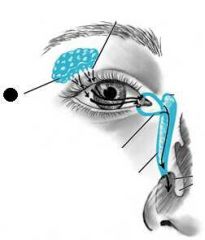
|
• Lacrimal Glands
• secrete lacrimal fluid, or tears • Innervated by seventh cranial or facial nerve - reach the gland through branches of the trigeminal nerve - afferent nerve. |
|
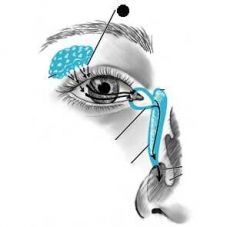
|
• Lacrimal Ducts
|
|
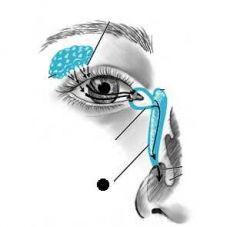
|
• Lacrimal Sac
|
|
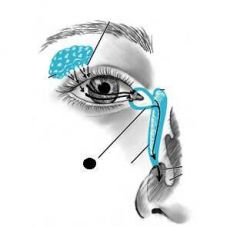
|
• Lacrimal Canal
|
|
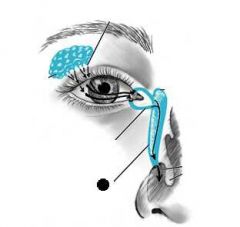
|
• Nasolacrimal Duct
|
|
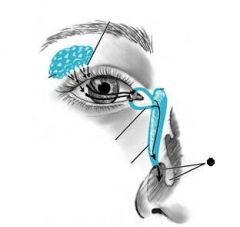
|
• Inferior Meatus and Turbinate
|
|
|
What is Dry Eye Syndrom (DES)?
|
• A.K.A Keratoconjunctivitis
• Persistant dryness, scratching, and burning in the eyes. |
|
|
What are salivary glands?
|
• Glands which produce saliva.
- Saliva lubricates and cleanses the oral cavity and helps in digestion. • Part of the immune system and digestive system. • Controlled by the autonomic nervious system (ANS). • Divided by size into major and minor glands • Both major and minor glands are exocrine glands and have ducts. |
|
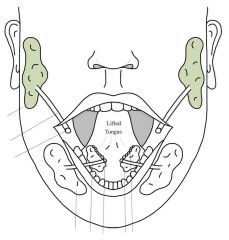
|
• Parotid Salivary Gland.
- Larges of the Three Major Salivary Glands - Encapsulated - Serous Saliva - Produces 25% of the total saliva. • Divided into two lobesL superficial and deep. • Innervated by the motor efferent nerves of the ninth cranial or glossopharyngeal nerve, as well as by the afferent nerves from the auriculotemporal branch ofthe trigeminal nerve. • seventh cranial or facial nerve and its branches travel through the gland but are NOT involved in innervation. |
|
|
What are conditions of the Parotid Gland?
|
Mumps
• A pathogenic disease that causes enlargement and tenderness of the parotid salivary glands. • Usually involves both glands, first one side, then the other, giving the characteristic "chipmunk" cheeks. Cancer • Changes the consistency of the gland and causes unilateral facial pain on the involved side because the facial nerve travels through the gland. Facial Paralysis • Caused when the gland is pierced and the facial nerve is temporarily traumatized when an inferior alveolar block is incorrectly administered. |
|
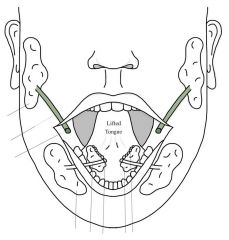
|
• Parotid Duct or Parotid Papilla
|
|
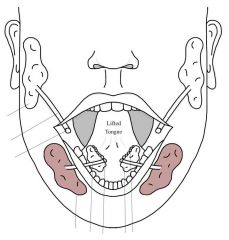
|
• Submandibular Salivary Gland
- Second Largest of the Three Major Salivary Glands - Encapsulated - Mixed serous and mucous secretions - Provides 65% of total saliva • Innervated y efferent fibers of the chorda tympani and the submandibular ganglion of the seventh cranial or facial nerve. |
|
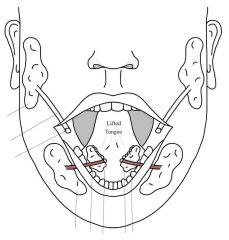
|
• Submandibular Duct or Wharton Duct.
• Opening at sublingual caruncle, a small papilla near the midline on each side of the lingual frenum. • Travels along floor of the mouth toward distance. - Most common in salivary stone formation. |
|
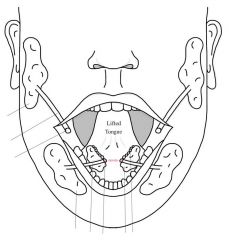
|
• Sublingual Caruncle
|
|
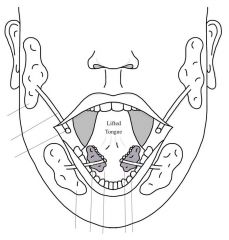
|
• Sublingual Salivary Gland
- Smallest of the Three Major Salivary Glands - Unencapsulated - Mixed serous and mucosa secretions. - Provides 10% of total saliva. • Innervated by efferent fibers of the chorda tympani nerve and the submandibular ganglion of the seventh cranial or facial nerve. • Drains into the submandibular lymph nodes • Supplied by sublingual and submental arteries. |
|
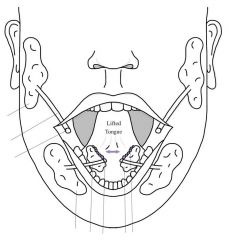
|
• Sublingual Duct or Bartholin Duct
- Opens directly into the oral cavity through the sublingual caruncle. |
|
|
Minor Salivary Glands
|
• Smaller than Major salivary glands.
• Are more numerous. • Are scattered in tissue: buccal, labial, lingual, soft palate, lateral parts of the hard palate, and the floor of the mouth. • Drain into various lymph nodes / are supplied by various arteries depending on location. • innervated by the seventh cranial or facial nerve |
|
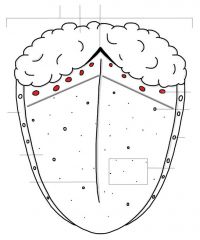
Which minor glands are located within these?
|
• Von Ebner's salivary glands.
• Produce serous saliva only. |
|
|
What are salivary stones?
|
• formations of mineralized saliva which block the drainage of saliva and cause gland enlargement and tenderness.
- Ranula involves the major glands. - Mucocele involves the minor glands. • Affected salivary gland may need to be surgically removed if there are repeated stone formations or related infections. |
|
|
What is hyposalivation?
|
• A reduced production of saliva.
• Can result in Xerostomia (dry mouth) • Can be caused by certain medications, disease or destruction of the salivary tissue by radiation therapy. |
|
|
What is halitosis?
|
Bad breath.
|
|
|
What causes Xerostomia
|
• Side affects of more than 400 medications.
• Diseases: Sjogren syndrom, HIV/AIDS, diabetes, and Parkinsons disease. • Radiation therapy: exposure to radiation. • Chemotherapy: drugs used to treat cancer can make the saliva thicker. • Nerve damage: injury to the head or neck can damage nerves that tell glands to make saliva. |
|
|
What are some signs and symptoms of Xerastomia?
|
• a sticky dry feeling in the mouth
• trouble chewing, swallowing, tasting, or speaking • a burning feeling in the mouth • a dry feeling in the throat • cracked lips • a dry, rough tongue, • mouth sores • an infection |
|
|
What is hyperkeratinization?
|
• Nicotinic Stomatitis
• An oral lesion associated with salivary glands caused by the heat from tabacco use or hot liquid consumption. • Look like extra salivary ducts on the hard palate. |
|

What gland is located here?
|
• Thyroid gland
- Butterfly-shaped - Largest endocrine gland - Located inferior to thyroid cartilage, junction between larynx and trachea. - Ductless - Consists of two lateral lobes, right and left, connected anteriorly by an isthmus. - Thyroxine(T4) and Triiodothyronine(T3) controle metabolism - influence heart rate, body temperature, alertness, mood, and many other functions. - Controled by the patuitary gland which releases Thyroid-Stimulating Harmone (TSH). • Innervated by sympathetic nerves through the cervical ganglia. • Drains into the superior deep cervical lymph nodes • Supplied by superior and inferior thyroid arteries. |
|
|
Hypothyroidism
|
• Most common is Hashimoto thyroidosis - autoimmune disorder attacks the gland
• Other causes are iodine therapy/thyroid surgery, developmental disterbances, iodine deficiency. • Associated with cretinism, or congenital lack of thyroxine; causing dwarfism with stocky stature, protruding abdomen, underdeveloped sex organs, misshapen face. • May have goiter. Oral Manifestations: - Kids - enlarged tongue and lips, delayed tooth eruption and possible enamel hypoplasia. - Adults - enlarged tongue; chronic severe peroidontal disease, slow, hoarse speach, possibly gingival hyperplasia. |
|
|
What is a goiter?
|
• An enlargement of the glan that is possibly visible in portions during extraoral exam.
• may be firm and tender when palpated and may contain hard masses. |
|
|
Hyperthyroidism
|
• Associated with Graves Disease - autoimmune hypertrophy of the gland.
• hypersecretion of thyroxine • Causes exophthalmos (protruding eyes) tachycardia, severe weight loss, sweating, tremors, heat intolerance, frequent bowel movement. • Treated by Radioactive Iodine or possible surgery. • Oral Manifestation - premature primary exfoliation, early eruption of permanents - aggressive periodontal disease, dental caries, osteoporosis of the jaw, burning tongue, increased salivation. |
|
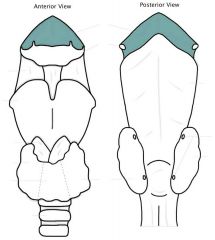
|
Middle Pharyngeal Constrictor
|
|
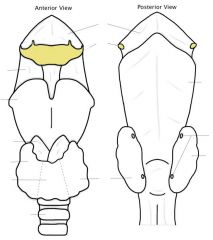
|
Hyoid Bone
|
|
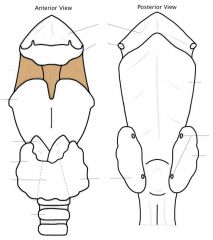
|
Thyrohyoid Membrane
|
|
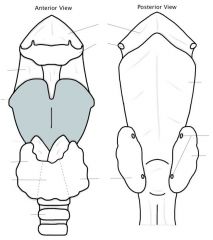
|
Thyroid Cartilage
|
|
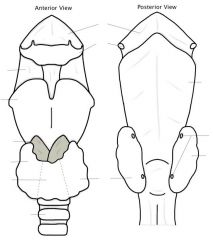
|
Cricothyroid Muscle
|
|

|
Right Lobe of the Thyroid Gland
|
|
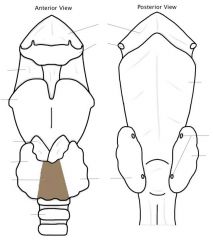
|
Isthmus of the Thyroid Gland
|
|
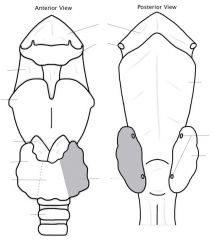
|
Left Lobe of the Thyroid Gland
|
|
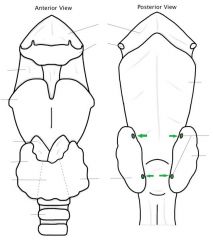
|
Parathyroid Glands
|
|
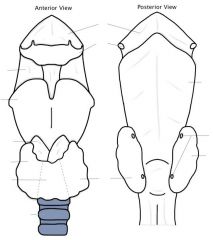
|
Trachea
|
|
|
Parathyroid Glands
|
• Consist of 4 small endocrin glands.
• Ductless • Produce and secrete parathyroid harmone directly into vascular system. • Located adjacent to/within posterior surface of thyroid gland. • Not visible or palpable during extraoral exam. • Innervated by the sympathetic nerves through the cervical ganglia. • Drain into superior deep cervical lymph nodes. • Supplied primarily by the inferior thyroid arteries. |
|
|
Thymus Gland
|
• Endocrine gland - ductless
• Two lateral lobes, right and left, connected by an isthmus at midline • located in the thorax, anterior region of the base of the neck, inferior to thyroid gland. • Part of Immune System • Grows from birth to puberty then starts to atrophy until it is gone in adulthood. • Innervated by branches of the tenth cranial or vagus nerve and cervical nerves • Lymphatic system arises within substance of gland and terminates in internal jugular vein. • Supplied by inferior thyroid and internal thoracic arteries. |
|
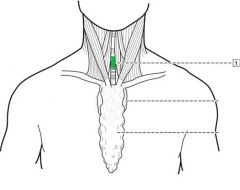
|
Thyroid Gland
|
|
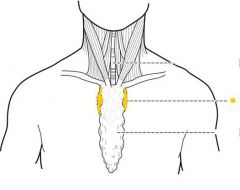
|
Right & Left Lobe of Thymus
|
|
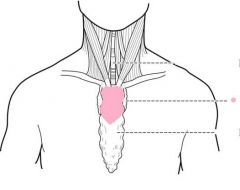
|
Isthmus of Thymus
|
|

|
Sternum
|
|
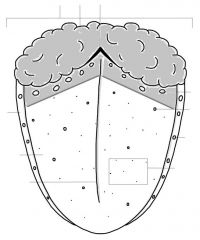
|
Base of the Tongue
|
|
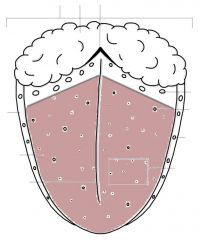
|
Body of the Tongue
|
|
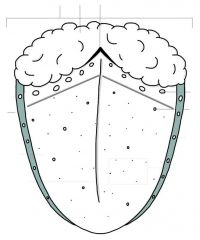
|
Lateral Border of the Tongue
|
|

|
Foramen Cecum
|
|
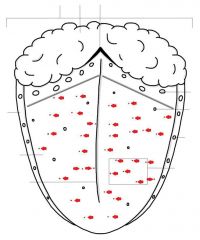
|
Filiform Papilla
|
|
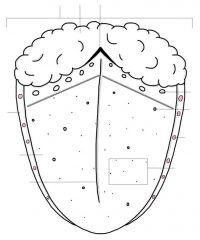
|
Foliate Papilla
|
|
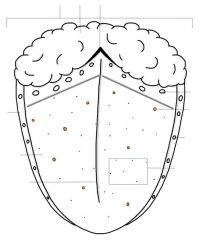
|
Fungiform Papilla
|
|

|
Lingual Tonsils
|
|
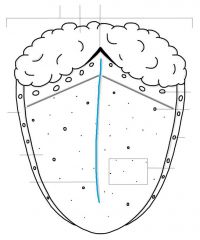
|
Median Lingual Sulcus
|
|
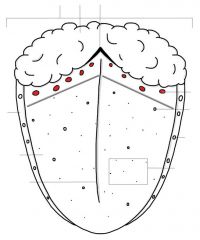
|
Circumvallate Papilla - Von Ebner's Salivary Glands
|

